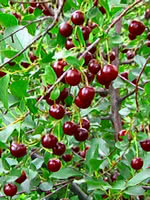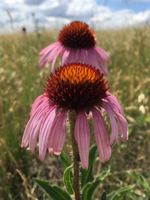Mon-Fri 9am - 5pm Mountain time
Cupid Cherry vs Narrow-Leaved Coneflower (Echinacea)
Prunus x kerrasis Cupid
Echinacea angustifolia
NOT AVAILABLE THIS SEASON - MIGHT RETURN
NOT AVAILABLE THIS SEASON - MIGHT RETURN
Cupid Cherry is a hardy deciduous hybrid shrub variety of Sour Cherry released in the Romance Series of dwarf sour cherries from the University of Saskatchewan in 2004. Cupid Cherry produces the largest fruit of all the sour cherries which is dark/red fruit and perfect for fresh eating but it tends to be a bit later than other varieties.
Narrow-Leaved Coneflower is a native perennial wildflower known for its pink to pale purple, daisy-like blooms. The petals (rays) droop downwards, around a dark, domed center, giving the flower a cone-like appearance. The nectar-rich blossoms attract a wide variety of pollinators, including native bees and butterflies. After flowering, the seeds provide food for birds, further adding to its ecological value.
Once established, it is drought-tolerant due to its deep taproot, which also helps stabilize soil. Narrow-Leaved Coneflower thrives in a variety of well-drained soils, including sandy, rocky, and alkaline. It often grows alongside the native grasses that characterize prairie and grassland ecosystems, making it well-suited for prairie and grassland restoration, naturalization, and pollinator gardens.

